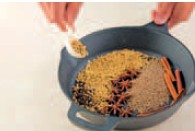Easy Indian Cooking (3 page)
Read Easy Indian Cooking Online
Authors: Hari Nayak



Roasting Meats
In Indian cooking roasting is traditionally done in a charcoal-fired
tandoor
(clay oven), which gives a unique flavor to roasted meats, breads and vegetables. The juices of the meats drip and sizzle on the charcoal and the smoke that is created gives the food its unique flavor. For home cooking, an open charcoal grill is good substitute for cooking meat kebabs, vegetables and paneer, though the flavor is milder than that achieved in a
tandoor
.
An oven can be used to make breads and also to roast marinated meats and vegetables.



Steaming
Dum
cooking has been described as the “maturing of a dish,” as in this technique the food is very slowly cooked in its own steam. Traditionally, the lid was sealed to the cooking vessel with a flour-and-water paste to make sure moisture stayed trapped within. The vessel was partially buried in hot coals and, to ensure the food was evenly surrounded by heat, some hot coals were placed on top of the lid. Today the modern oven is used to perform the function of providing even heat. The dish is first cooked on a stove top and then well sealed and placed in the oven to continue cooking in its own steam. The advantage of
dum
cooking is that because the vapors cannot escape, the food retains all of its delicate flavor and aroma.



Roasting and Grinding Your Spices at Home
Roasting (or toasting) is the key to enhancing the flavor of spices. It removes the raw smell that untreated spices tend to have and intensifies their flavors by heating up essential oils. All you need is a small, heavy-bottomed skillet (cast iron works great). No oil is used when roasting spices. Whole spices are put in a dry skillet and roasted over medium heat until the spices turn a shade or two darker and become aromatic. The spices are then immediately removed from the hot skillet to avoid over-roasting them.
In my kitchen I generally buy the spices whole and then grind them myself as I need them. Because spices retain their flavor and aroma much longer in their whole state rather than when ground, grinding roasted spices in small batches is the ideal way to use them, and gives the greatest possible flavor to dishes. Traditionally, spice grinding was done with heavy grinding-stones or a mortar and pestle. To save time, I grind spices using a spice grinder, though a coffee grinder works equally well.



Sautéing
Unlike classic French sautéing,
bhunao
is a combination of sautéing, stir-frying and light stewing. It is the process of cooking over medium to high heat, adding small quantities of liquid, such as water or tomato purée, and stirring constantly to prevent the ingredients from sticking. Almost every Indian recipe needs
bhunao
at some stage, and some at more than one stage. Generally ingredients like onions, ginger, garlic, tomatoes and spices require
bhunao
to extract the flavor of each of the ingredients in combination with spices and to ensure that the
masala
is fully cooked before adding the main ingredient. Sometimes the main ingredient, such as poultry, meats or vegetables, may also require
bhunao
.
The process of making
masala
is complete only when the fat leaves the
masala
,
which is critical in Indian cooking. Traditionally a
kadhai
(Indian wok) is used for this technique, but a heavy-bottomed saucepan or other deep-sided pan, such as a braiser or Dutch oven, works as well.
